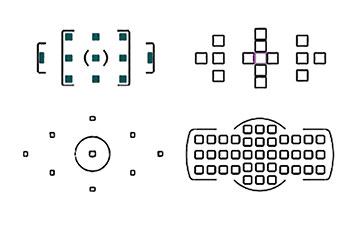A big part of making a pleasing image is in how you frame your subject. In the realm of convention photography, I personally think anything goes in regards to framing. There are well known framing techniques, which I will go into later, but don’t be afraid to try new things and don’t worry what others might think or say if you don’t follow common practices. See your subject(s) and imagine the possibilities of their pose considering angle of view. If their pose does not work, try suggesting an alternative or fix something that does not jive with the image you are trying to create by changing perspective. When “out in the field,” or rather on the convention floor, you will be rushed and cramped at times, so work with what you have.

If you use your camera in generic auto (focus) mode, there is no telling what area of the image the camera will decide to focus on. So to get around that, I often use the camera in focal-point selection mode. For example, my camera has 11 auto-focus points that I can select from as the focal point.
When using this mode, I line up their face on the desired focal point in my camera, so I can make certain to get their face in the best sharpness possible. If your camera does not have the ability to select which focal point to use out of the auto-focus point array, you can just use the center point focus mode and re-compose after gaining focus on their face. Aim the center point at their face and then tilt the camera’s angle to locate that focal point in different part of the frame to improve overall interest in the image. The only negative is there might be slight focus errors as you recompose to take the shot, so your results might vary a bit with extremely large aperture lenses.
Beside where to place your subject in the frame, take into consideration how much of the frame you want to fill with them. That means deciding on how far or how close you want to be from your subject to further emphasize or not emphasize the background and foreground features. If your subject’s costume fits in with the background, it would be in your best interest to have a few shots with a background that is not completely blurred out. On the other hand, if your background is just a busy mess, try to modify your camera settings to make the background fade away in a strong blur.
- Overview
- Who is this for?
- What is convention photography?
- My experience and experiences
- Why be a part of this?
- Practice, practice, practice!
- Networking
- Fun
- Photography terms primer.
- Equipment
- It is important or not depending on your ideals
- A basic setup.
- Decide how you want to make it work.
- Framing and composition
- Full body shots.
- Portrait style.
- Skewed angles.
- Face in detail.
- Plane of focus.
- Rule of thirds and golden ratio
- Available light photography.
- Strobe photography.
- Removing harsh light.
- Flash brackets.
- Bokeh and blur maximization.
- Histogram reading and image review.
- Post processing.
- Various schools of thought.
- Available software on your OS of choice.
- Ideas on how to improve your processing.
- Business cards.
- Social networking.
- Website
- The process from start to finish.
- My equipment.
- Ask the person first.
- Interrupting people.
- Constrained areas.
- Physical activity.
- Summary
